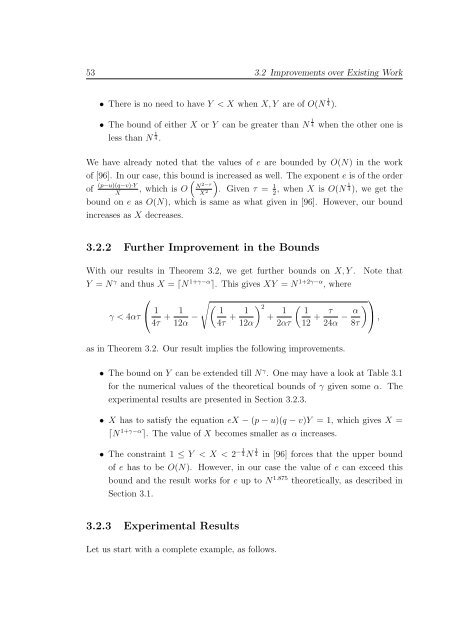Cryptanalysis of RSA Factorization - Library(ISI Kolkata) - Indian ...
Cryptanalysis of RSA Factorization - Library(ISI Kolkata) - Indian ...
Cryptanalysis of RSA Factorization - Library(ISI Kolkata) - Indian ...
You also want an ePaper? Increase the reach of your titles
YUMPU automatically turns print PDFs into web optimized ePapers that Google loves.
53 3.2 Improvements over Existing Work<br />
• There is no need to have Y < X when X,Y are <strong>of</strong> O(N 1 4).<br />
• The bound <strong>of</strong> either X or Y can be greater than N 1 4 when the other one is<br />
less than N 1 4.<br />
We have already noted that the values <strong>of</strong> e are bounded by O(N) in the work<br />
<strong>of</strong> [96]. In our case, this bound ( is increased as well. The exponent e is <strong>of</strong> the order<br />
<strong>of</strong> (p−u)(q−v)·Y N<br />
, which is O<br />
). 2−τ<br />
Given τ = 1, when X is O(N 1 4), we get the<br />
X<br />
X 2 2<br />
bound on e as O(N), which is same as what given in [96]. However, our bound<br />
increases as X decreases.<br />
3.2.2 Further Improvement in the Bounds<br />
With our results in Theorem 3.2, we get further bounds on X,Y. Note that<br />
Y = N γ and thus X = ⌈N 1+γ−α ⌉. This gives XY = N 1+2γ−α , where<br />
γ < 4ατ<br />
⎛ √ (<br />
⎝ 1<br />
4τ + 1 1<br />
12α − 4τ + 1 ) 2<br />
+ 1<br />
12α 2ατ<br />
( 1<br />
12 + τ<br />
24α − α ) ⎞ ⎠,<br />
8τ<br />
as in Theorem 3.2. Our result implies the following improvements.<br />
• The bound on Y can be extended till N γ . One may have a look at Table 3.1<br />
for the numerical values <strong>of</strong> the theoretical bounds <strong>of</strong> γ given some α. The<br />
experimental results are presented in Section 3.2.3.<br />
• X has to satisfy the equation eX −(p−u)(q −v)Y = 1, which gives X =<br />
⌈N 1+γ−α ⌉. The value <strong>of</strong> X becomes smaller as α increases.<br />
• The constraint 1 ≤ Y < X < 2 −1 4N 1 4 in [96] forces that the upper bound<br />
<strong>of</strong> e has to be O(N). However, in our case the value <strong>of</strong> e can exceed this<br />
bound and the result works for e up to N 1.875 theoretically, as described in<br />
Section 3.1.<br />
3.2.3 Experimental Results<br />
Let us start with a complete example, as follows.
















